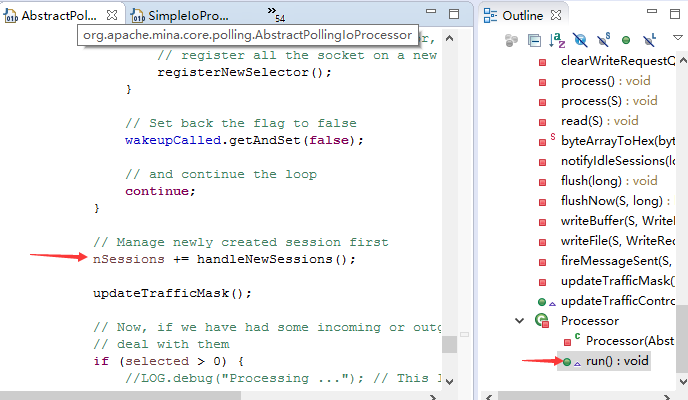Android基于基于布局嵌套的页面导航实现
mina架构图
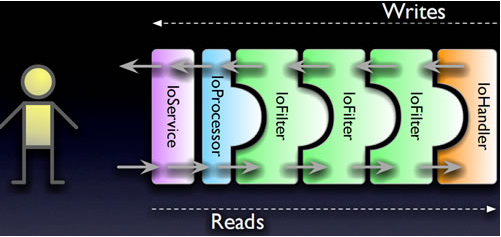
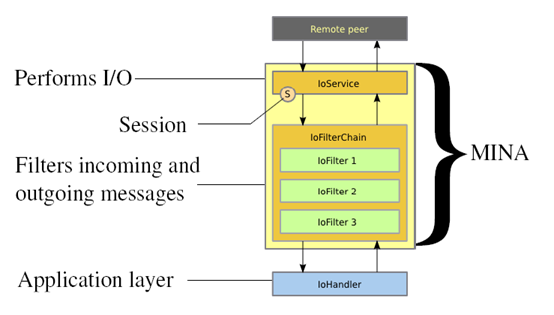
写数据、读数据触发点:
写数据:
1、写操作很简单,是调用session的write方法,进行写数据的,写数据的最终结果保存在一个缓存队列里面,等待发送,并把当前session放入flushSession队列里面。
2、发数据其实和读数据是差不多的,都在Processor中的触发的,在process()完新消息后,会调用flush()方法,把flushSession队列里面的session取出来,并把缓存的消息发送到客户端。
读数据:
读操作是在Processor中的触发的,Processor是AbstractPollingIoProcessor的内部私有类。
Processor中有一个死循环,循环调用Selector的select方法,若有新消息,则进行process()。
写数据过程
MINA数据类型
ByteBuffer、IoBuffer、Object。ByteBuffer是Java的NIO接口从channel读取数据的数据类型;IoBuffer是MINA自定义的数据类型,它封装了ByteBuffer;Object是用户自定义类型,通过用户自定义的codec与IoBuffer进行互相转换。
MINA数据类型转换流程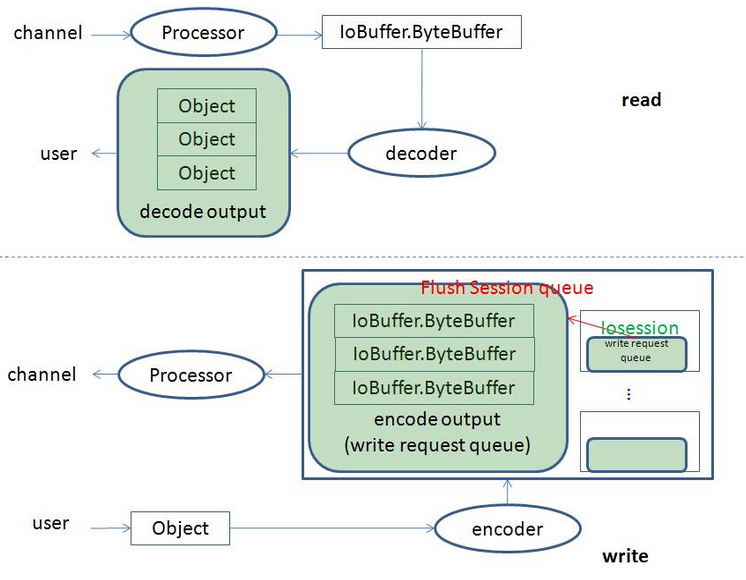
读数据过程
Processor从channel读取ByteBuffer数据,经MINA封装成IoBuffer提交给用户设置的decoder,decoder把解码结果放到一个解码输出队列(decode output queue)中,最后把队列元素按顺序提交给用户。如果设置了线程池来处理IO事件,那么Processor解码ByteBuffer数据以后的操作都由线程池执行,不然所有的操作都由Processor所在的线程执行。使用解码输出队列的原因是processor可能会收到的数据量超过decode成一个Object的所需要数据量,同时该队列是一个线程安全的,目的是防止在使用线程池运行IO事件时带来的数据竞争。
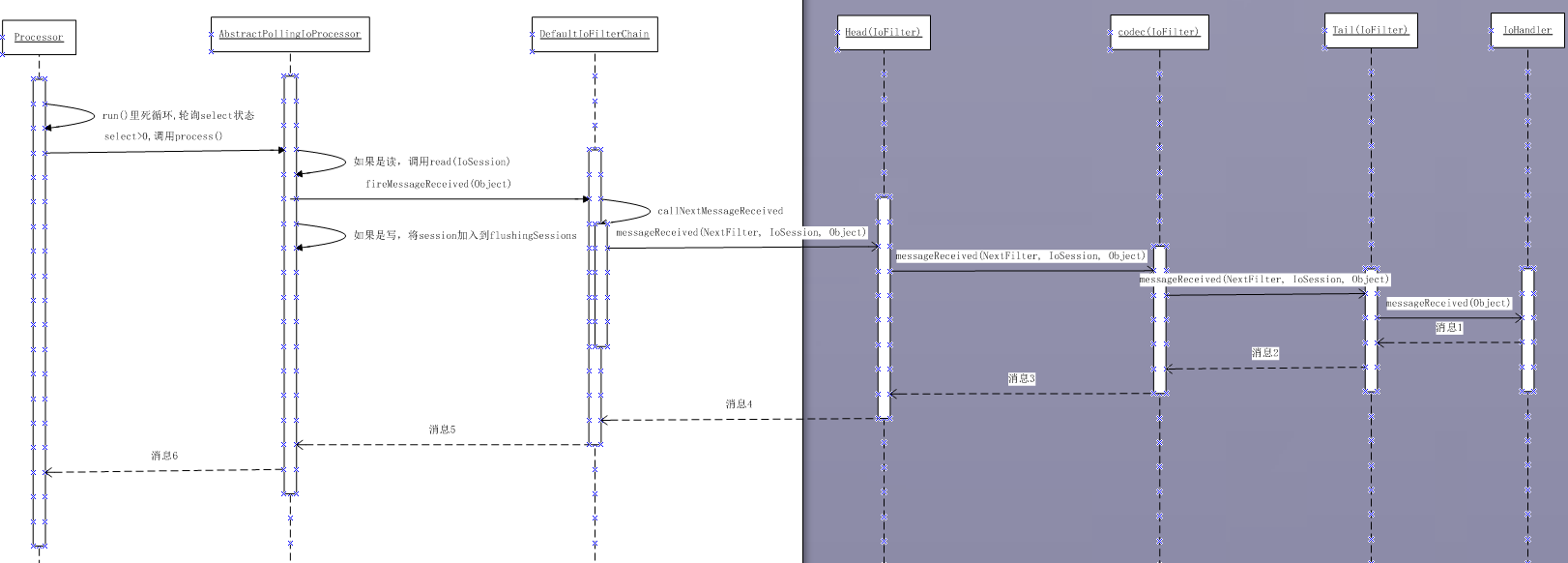
写数据过程
用户往IoSession中写入数据,通过encoder把用户类型的数据编码成IoBuffer并把它放入编码输出队列(写请求队列WriteRequestQueue),并把当前的IoSession放入Processor的刷新队列,最后Processor把每个IoSession中的写请求队列(WriteRequestQueue)中的数据写入channel。可以设置了运行IO事件的线程池执行在Processor处理之前的操作,不然这些操作都在用户写入IoSession的当前线程中执行。因为Processor所在线程跟用户往IoSession写数据的线程并不是同一个线程,所以需要一个线程安全的写请求队列(WriteRequestQueue)。
写数据:
通过eclipse的单步调试:session.write()-->AbsructIoSession.write()-->DefaultIoFilterChain.fireFilterWrite()-->DefaultIoFilterChain.callPreviousFilterWrite()-->HeadFilter.filterWrite()-->SimpleIoProcessorPool-->IoProcessor(线程).write()
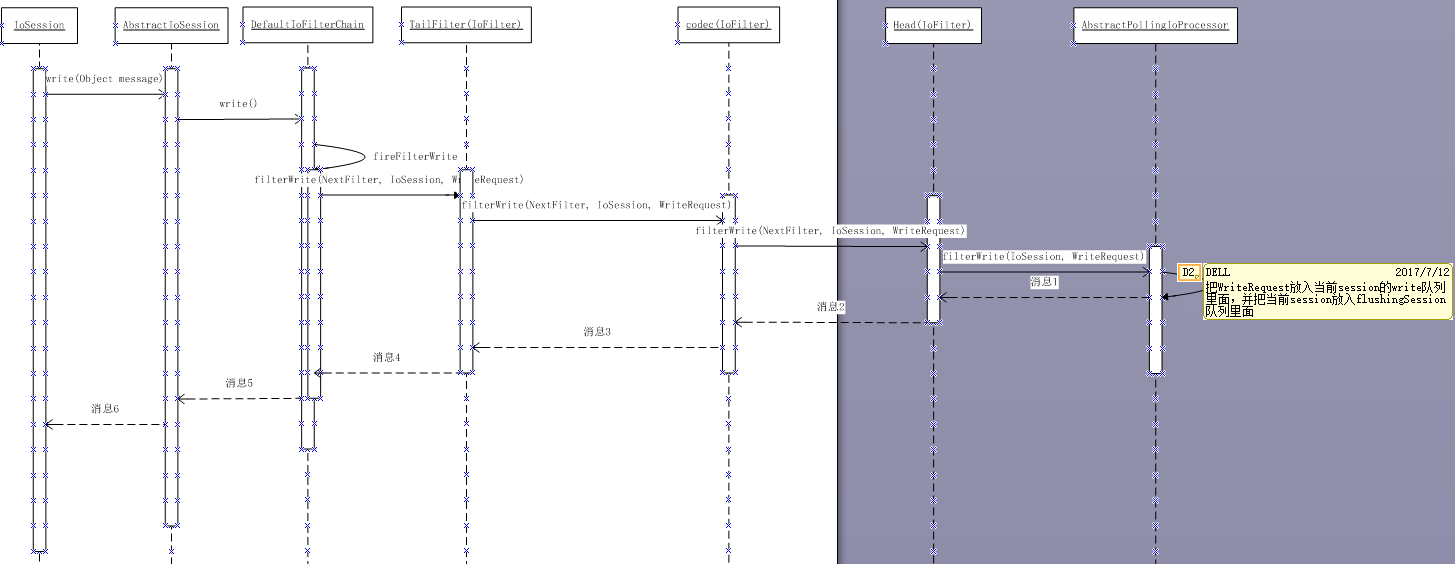
在最后一个Filter也就是HeadFilter中,会获取IoSession与之相关的 WriteRequestQueue 队列,作为应用层写出数据缓冲区。 把写出的WriteRequest放到写出缓冲区队列中。
因为apache mina 是按照SEDA架构设计,同时把要写出数据的IoSession放在 WriteRequestQueue队列中等待写出数据。

再看HeadFilter:

再来看 WriteRequestQueue中的数据是怎么处理的。
然后在Processor线程的run()方法中,来轮询flushIoSession队列。
AbstractPollingIoProcessor$Processor.run()-->AbstractPollingIoProcessor.flush(currentTime)-->AbstractPollingIoProcessor.flushNow(session, currentTime)-->
在NioProcessor(AbstractPollingIoProcessor<S>).flushNow(S, long) 方法中,依次把同一个IoSession中的writeRequest 请求写入到系统缓冲区。
private boolean flushNow(S session, long currentTime) {
if (!session.isConnected()) {
scheduleRemove(session);
return false;
}
final boolean hasFragmentation = session.getTransportMetadata().hasFragmentation();
final WriteRequestQueue writeRequestQueue = session.getWriteRequestQueue();
// Set limitation for the number of written bytes for read-write
// fairness. I used maxReadBufferSize * 3 / 2, which yields best
// performance in my experience while not breaking fairness much.
final int maxWrittenBytes = session.getConfig().getMaxReadBufferSize()
+ (session.getConfig().getMaxReadBufferSize() >>> 1);
int writtenBytes = 0;
WriteRequest req = null;
try {
// Clear OP_WRITE
setInterestedInWrite(session, false);
do {
// Check for pending writes.
req = session.getCurrentWriteRequest();
if (req == null) {
req = writeRequestQueue.poll(session);
if (req == null) {
break;
}
session.setCurrentWriteRequest(req);
}
int localWrittenBytes = 0;
Object message = req.getMessage();
if (message instanceof IoBuffer) {
localWrittenBytes = writeBuffer(session, req, hasFragmentation, maxWrittenBytes - writtenBytes,
currentTime);
if ((localWrittenBytes > 0) && ((IoBuffer) message).hasRemaining()) {
// the buffer isn't empty, we re-interest it in writing
writtenBytes += localWrittenBytes;
setInterestedInWrite(session, true);
return false;
}
} else if (message instanceof FileRegion) {
localWrittenBytes = writeFile(session, req, hasFragmentation, maxWrittenBytes - writtenBytes,
currentTime);
// Fix for Java bug on Linux
// http://bugs.sun.com/bugdatabase/view_bug.do?bug_id=5103988
// If there's still data to be written in the FileRegion,
// return 0 indicating that we need
// to pause until writing may resume.
if ((localWrittenBytes > 0) && (((FileRegion) message).getRemainingBytes() > 0)) {
writtenBytes += localWrittenBytes;
setInterestedInWrite(session, true);
return false;
}
} else {
throw new IllegalStateException("Don't know how to handle message of type '"
+ message.getClass().getName() + "'. Are you missing a protocol encoder?");
}
if (localWrittenBytes == 0) {
// Kernel buffer is full.
setInterestedInWrite(session, true);
return false;
}
writtenBytes += localWrittenBytes;
if (writtenBytes >= maxWrittenBytes) {
// Wrote too much
scheduleFlush(session);
return false;
}
} while (writtenBytes < maxWrittenBytes);
} catch (Exception e) {
if (req != null) {
req.getFuture().setException(e);
}
IoFilterChain filterChain = session.getFilterChain();
filterChain.fireExceptionCaught(e);
return false;
}
return true;
}
如何在应用层缓冲区的写出数据全部写入到系统缓冲区后才关闭socket
关闭socket,从IoSession开始:IoSession(boolean immediately)-->AstractIoSession.close(boolean rightNow)
如果参数是true:-->AstractIoSession.close()
如果参数是false:-->AstractIoSession.closeOnFlush():创建了一个CLOSE_Request请求,当轮询flushIosession时,调用了close()方法。因为IoSession.close(flase) 也是一个写请求队列,所以在处理CLOSE_REQUEST请求时,之前的应用层缓冲区数据已经写入到系统缓冲区中。
CloseFuture close(boolean immediately);
IoSession的默认实现类AstractIoSession:
public final CloseFuture close(boolean rightNow) {
if (!isClosing()) {
if (rightNow) {
return close();
}
return closeOnFlush();
} else {
return closeFuture;
}
}
private final CloseFuture closeOnFlush() {
getWriteRequestQueue().offer(this, CLOSE_REQUEST);
getProcessor().flush(this);
return closeFuture;
}
CLOSE_REQUEST:(AbstractIoSession)
/**
* An internal write request object that triggers session close.
*
* @see #writeRequestQueue
*/
private static final WriteRequest CLOSE_REQUEST = new DefaultWriteRequest(new Object());
AbstractIoSession里的writeRequestQueue是CloseAwareWriteQueue
/**
* Create a new close aware write queue, based on the given write queue.
*
* @param writeRequestQueue
* The write request queue
*/
public final void setWriteRequestQueue(WriteRequestQueue writeRequestQueue) {
this.writeRequestQueue = new CloseAwareWriteQueue(writeRequestQueue);
}


NioProcessor(AbstractPollingIoProcessor<S>)
AbstractPollingIoProcessor
/** A queue used to store the sessions to be removed */
private final Queue<S> removingSessions = new ConcurrentLinkedQueue<S>();
AbstractPollingIoProcessor$Processor.run()-->NioProcessor(AbstractPollingIoProcessor<S>).removeSessions()
private class Processor implements Runnable {
public void run() {
assert (processorRef.get() == this);
int nSessions = 0;
lastIdleCheckTime = System.currentTimeMillis();
for (;;) {
try {
// This select has a timeout so that we can manage
// idle session when we get out of the select every
// second. (note : this is a hack to avoid creating
// a dedicated thread).
long t0 = System.currentTimeMillis();
int selected = select(SELECT_TIMEOUT);
long t1 = System.currentTimeMillis();
long delta = (t1 - t0);
if ((selected == 0) && !wakeupCalled.get() && (delta < 100)) {
// Last chance : the select() may have been
// interrupted because we have had an closed channel.
if (isBrokenConnection()) {
LOG.warn("Broken connection");
// we can reselect immediately
// set back the flag to false
wakeupCalled.getAndSet(false);
continue;
} else {
LOG.warn("Create a new selector. Selected is 0, delta = " + (t1 - t0));
// Ok, we are hit by the nasty epoll
// spinning.
// Basically, there is a race condition
// which causes a closing file descriptor not to be
// considered as available as a selected channel, but
// it stopped the select. The next time we will
// call select(), it will exit immediately for the same
// reason, and do so forever, consuming 100%
// CPU.
// We have to destroy the selector, and
// register all the socket on a new one.
registerNewSelector();
}
// Set back the flag to false
wakeupCalled.getAndSet(false);
// and continue the loop
continue;
}
// Manage newly created session first
nSessions += handleNewSessions();
updateTrafficMask();
// Now, if we have had some incoming or outgoing events,
// deal with them
if (selected > 0) {
//LOG.debug("Processing ..."); // This log hurts one of the MDCFilter test...
process();
}
// Write the pending requests
long currentTime = System.currentTimeMillis();
flush(currentTime);
// And manage removed sessions
nSessions -= removeSessions();
// Last, not least, send Idle events to the idle sessions
notifyIdleSessions(currentTime);
// Get a chance to exit the infinite loop if there are no
// more sessions on this Processor
if (nSessions == 0) {
processorRef.set(null);
if (newSessions.isEmpty() && isSelectorEmpty()) {
// newSessions.add() precedes startupProcessor
assert (processorRef.get() != this);
break;
}
assert (processorRef.get() != this);
if (!processorRef.compareAndSet(null, this)) {
// startupProcessor won race, so must exit processor
assert (processorRef.get() != this);
break;
}
assert (processorRef.get() == this);
}
// Disconnect all sessions immediately if disposal has been
// requested so that we exit this loop eventually.
if (isDisposing()) {
for (Iterator<S> i = allSessions(); i.hasNext();) {
scheduleRemove(i.next());
}
wakeup();
}
} catch (ClosedSelectorException cse) {
// If the selector has been closed, we can exit the loop
break;
} catch (Throwable t) {
ExceptionMonitor.getInstance().exceptionCaught(t);
try {
Thread.sleep(1000);
} catch (InterruptedException e1) {
ExceptionMonitor.getInstance().exceptionCaught(e1);
}
}
}
try {
synchronized (disposalLock) {
if (disposing) {
doDispose();
}
}
} catch (Throwable t) {
ExceptionMonitor.getInstance().exceptionCaught(t);
} finally {
disposalFuture.setValue(true);
}
}
}
可以看到这个类实现了Runnable接口, run方法中的for循环一直在处理IOSession的数据读取和写入。
int selected = select(SELECT_TIMEOUT); SELECT_TIMEOUT 的默认值为1000L 所以超时时间设置为1S 如果有数据可写或者数据可读 则返回值大于0
if ((selected == 0) && !wakeupCalled.get() && (delta < 100)) 这个地方主要是处理判断是已经断开的连接还是新建立的连接 对于delta 为什么小于100
这个暂时还不知道 哦,这个是个nio的bug 链接可以看下 http://maoyidao.iteye.com/blog/1739282
selected大于0 则开始处理IOSession的读写。
如果可读
IoFilterChain filterChain = session.getFilterChain();
filterChain.fireMessageReceived(buf);
DefaultIoFilterChain实现fireMessageReceived的方法来处理
再由实现IoFilter接口的实现类来处理消息 基本上就结束了。
IoFilter有编解码,日志,线程池 这个有很多大家可以看下API。
private int removeSessions() {
int removedSessions = 0;
for (S session = removingSessions.poll(); session != null; session = removingSessions.poll()) {
SessionState state = getState(session);
// Now deal with the removal accordingly to the session's state
switch (state) {
case OPENED:
// Try to remove this session
if (removeNow(session)) {
removedSessions++;
}
break;
case CLOSING:
// Skip if channel is already closed
break;
case OPENING:
// Remove session from the newSessions queue and
// remove it
newSessions.remove(session);
if (removeNow(session)) {
removedSessions++;
}
break;
default:
throw new IllegalStateException(String.valueOf(state));
}
}
return removedSessions;
}
如果在IoSession真正关闭时,有数据尚未写入到系统缓冲区,将会有异常抛出。
AbstractPollingIoProcessor<S extends AbstractIoSession>.removeNow(S session)-->AbstractPollingIoProcessor<S extends AbstractIoSession>.clearWriteRequestQueue()
private void clearWriteRequestQueue(S session) {
WriteRequestQueue writeRequestQueue = session.getWriteRequestQueue();
WriteRequest req;
List<WriteRequest> failedRequests = new ArrayList<WriteRequest>();
if ((req = writeRequestQueue.poll(session)) != null) {
Object message = req.getMessage();
if (message instanceof IoBuffer) {
IoBuffer buf = (IoBuffer) message;
// The first unwritten empty buffer must be
// forwarded to the filter chain.
if (buf.hasRemaining()) {
buf.reset();
failedRequests.add(req);
} else {
IoFilterChain filterChain = session.getFilterChain();
filterChain.fireMessageSent(req);
}
} else {
failedRequests.add(req);
}
// Discard others.
while ((req = writeRequestQueue.poll(session)) != null) {
failedRequests.add(req);
}
}
// Create an exception and notify.
if (!failedRequests.isEmpty()) {
WriteToClosedSessionException cause = new WriteToClosedSessionException(failedRequests);
for (WriteRequest r : failedRequests) {
session.decreaseScheduledBytesAndMessages(r);
r.getFuture().setException(cause);
}
IoFilterChain filterChain = session.getFilterChain();
filterChain.fireExceptionCaught(cause);
}
}
参考:
http://blog.csdn.net/smart_k/article/details/6617334
http://blog.csdn.net/wzm112358/article/details/46409181
Android基于基于布局嵌套的页面导航实现的更多相关文章
- Android零基础入门第35节:Android中基于回调的事件处理
原文:Android零基础入门第35节:Android中基于回调的事件处理 通过前面两期掌握了Android中基于监听的事件处理的五种形式,那么本期一起来学习Android中基于回调的事件处理. 一. ...
- Android零基础入门第34节:Android中基于监听的事件处理
原文:Android零基础入门第34节:Android中基于监听的事件处理 上一期我们学习了Android中的事件处理,也详细学习了Android中基于监听的事件处理,同时学会了匿名内部类形式,那么本 ...
- 基于JQuery实现滚动到页面底端时自动加载更多信息
基于JQuery实现滚动到页面底端时自动加载更多信息 关键代码: 代码如下: var stop=true; $(window).scroll(function(){ totalheight = par ...
- 强大!基于拖放布局的 Twitter Bootstrap 网站生成器
强大!基于拖放布局的 Twitter Bootstrap 网站生成器 网址如下 http://www.layoutit.com/build http://demo.sc.chinaz.com/File ...
- Android之基于HTTP协议的下载
Android之基于HTTP协议的下载 http://www.blogjava.net/zh-weir/archive/2010/05/02/319892.html http://www.qianfa ...
- 【Android】基于TCP协议的网络通信
1.使用ServerSocket 创建TCP服务器端: ServerSocket server; try { server = new ServerSocket(8000); while (true) ...
- Https系列之四:https的SSL证书在Android端基于okhttp,Retrofit的使用
Https系列会在下面几篇文章中分别作介绍: 一:https的简单介绍及SSL证书的生成二:https的SSL证书在服务器端的部署,基于tomcat,spring boot三:让服务器同时支持http ...
- Asp.Net Core 2.0 项目实战(11) 基于OnActionExecuting全局过滤器,页面操作权限过滤控制到按钮级
1.权限管理 权限管理的基本定义:百度百科. 基于<Asp.Net Core 2.0 项目实战(10) 基于cookie登录授权认证并实现前台会员.后台管理员同时登录>我们做过了登录认证, ...
- Android应用---基于NDK的samples例程hello-jni学习NDK开发
Android应用---基于NDK的samples例程hello-jni学习NDK开发 NDK下载地址:http://developer.android.com/tools/sdk/ndk/index ...
随机推荐
- 【hadoop2.6.0】用C++ 编写mapreduce
hadoop通过hadoop streaming 来实现用非Java语言写的mapreduce代码. 对于一个一点Java都不会的我来说,这真是个天大的好消息. 官网上hadoop streaming ...
- 深入浅出ES6(五):不定参数和默认参数
作者 Jason Orendorff github主页 https://github.com/jorendorff 不定参数 我们通常使用可变参函数来构造API,可变参函数可接受任意数量的参数.例 ...
- django --fields.E304 错误解决方案
今天在同一个表里,有多个不同的用户集时出现. fields.E304: Field name <field name> clashes with accessor for <fiel ...
- C# Regex类用法
使用Regex类需要引用命名空间:using System.Text.RegularExpressions; 利用Regex类实现全部匹配输出 string str = "test43232 ...
- Biba模型简介
上周上信息安全的课,老师留了个Biba模型的作业.自己看书了解了一下,记录如下. 参考资料:石文昌<信息系统安全概论第2版> ISBN:978-7-121-22143-9 Biba模型是毕 ...
- 李洪强iOS开发之【Objective-C】09-空指针和野指针
一.什么是空指针和野指针 1.空指针 1> 没有存储任何内存地址的指针就称为空指针(NULL指针) 2> 空指针就是被赋值为0的指针,在没有被具体初始化之前,其值为0. 下面两个都是空指针 ...
- RN学习1——前奏,app插件化和热更新的探索
react_native_banner-min.png React Native(以下简称RN)有大量前端开发者的追捧.前端开发是一个活跃的社区,一直尝试着一统前后端,做一个全栈开发,RN就是他们在客 ...
- C# 任意类型数据转JSON格式(转)
HOT SUMMER 每天都是不一样,积极的去感受生活 C# 任意类型数据转JSON格式 /// <summary> /// List转成json /// </summary> ...
- *EditPlus注册码在线生成
http://www.jb51.net/tools/editplus/
- Checked&Unchecked Exception
Java 中定义了两类异常: 1) Checked exception: 这类异常都是Exception的子类 .异常的向上抛出机制进行处理,如果子类可能产生A异常,那么在父类中也必须throws A ...

